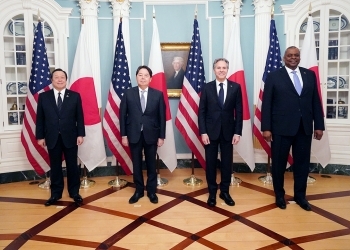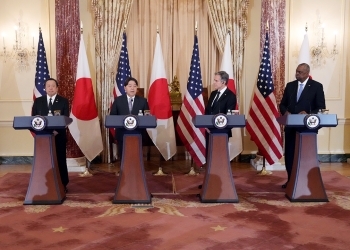Japan-United States of America Relations
Japan-U.S. Security Consultative Committee (Japan-U.S. “2+2”)


On January 12, commencing at 4:00 a.m.(2:00 p.m. on January 11, U.S. time) for approximately 2 hours and 30 minutes, the Japan-U.S. Security Consultative Committee (SCC) (Japan-U.S. “2+2”) was convened in Washington, D.C. The meeting was attended by Mr. HAYASHI Yoshimasa, Minister for Foreign Affairs, and Mr. HAMADA Yasukazu, Minister of Defense, from the Japanese side, and the Honorable Antony Blinken, Secretary of State, and the Honorable Lloyd Austin, Secretary of Defense, from the U.S. side. The overview of the meeting is as follows (a Joint Statement (PDF) was released following the meeting).
was released following the meeting).
1. Overview
- (1) At the beginning of the meeting, the U.S. side expressed its sincere welcome to the visit of the two Japanese ministers to the U.S. and its great pleasure that this JapanU.S. "2+2" could be held face-to-face for the first time in two years in a timely manner, immediately after the release of the strategic documents of the two countries. They also stated that the importance of the Japan-U.S. Alliance has never been higher than ever amidst an increasingly severe security environment, and they also stated that they would like to demonstrate the unwavering U.S. commitment to the Indo-Pacific region to achieve a “Free and Open Indo-Pacific." The Japanese side stated that this is an excellent opportunity to have discussion on further deepening of the Alliance, while aligning the two countries' perceptions of the security environment, based on both countries’ strategic documents. They added that they are fully committed to continuously strengthening the Alliance and sincerely look forward to working closely with the two Secretaries. They also stated that the strategies do not end when they are formulated, and it is important to work together to promptly implement their respective strategies.
- (2) Japan and the U.S. welcomed the release of their respective National Security Strategies and National Defense Strategies, and confirmed unprecedented alignment of their vision, priorities, and goals.
- (3) The Japanese side stated that, it would reinforce its defense capabilities by acquiring new capabilities and enhancing its warfighting sustainability early under the substantially increased defense budget. In response, the U.S. side stated that this is an important initiative to strengthen Alliance deterrence and response capabilities, and stated that the U.S. strongly supports this initiative.
- (4) The U.S. side restated its unwavering commitment to the defense of Japan under Article V of the Japan-U.S. Security Treaty, using its full range of capabilities, including nuclear, and reaffirmed Article V of the Japan-U.S. Security Treaty applies to the Senkaku Islands.
2. Regional Security Environment
The Japanese side stated that Japan will strengthen its diplomatic and security roles to proactively create a peaceful and stable international environment, and to enhance a free and open international order based on the rule of law. Then both sides aligned their perspectives on the security environment as follows:
- (1) Japan and the U.S. concurred that China's foreign policy-based actions aimed at reshaping the international order for its own benefit are of serious concern to the Alliance and the entire international community, and pose the greatest strategic challenge in the Indo-Pacific region, and beyond.
- (2) The U.S. side also reiterated its strong opposition to China’s intensified attempts to unilaterally change the status quo by force in the East China Sea, including through actions that seek to undermine Japan’s longstanding administration of the Senkaku Islands.
- (3) Japan and the U.S. recognized that their basic positions on Taiwan remain unchanged, and reiterated the importance of maintaining peace and stability across the Taiwan Strait as an indispensable element of security and prosperity in the international community and encouraged the peaceful resolution of cross-Strait issues.
- (4) Japan and the U.S strongly condemned North Korea’s unprecedented number of unlawful and reckless ballistic missile launches over the past year. The Japanese side stated that if North Korea ,which has announced its policy of mass production of tactical nuclear weapons and other initiatives, decides to conduct another nuclear test, this test needs to be recognized as an event that is completely different from the previous six nuclear tests. In addition, the U.S. side expressed its full support for the abductions issue.
- (5) Japan and the U.S. strongly condemned Russia’s brutal, unprovoked, and unjustifiable war against Ukraine. The Japanese side stated that the security of Europe and the Indo-Pacific region are indivisible, and that as the G7 chair this year, Japan will lead the discussion on how to respond to Russia and support Ukraine.
3. Modernizing the Alliance
The Japanese side stated that the strategies of both countries are aligned in that both sides seek to fundamentally reinforce their own defense capabilities to enhance deterrence, to increase investment for this purpose, and to strengthen cooperation with allies and like-minded countries. The both sides discussed measures to maximize Alliance deterrence and response capabilities under their strategies.
- (1) The Japanese side stated that it is necessary to achieve a more effective division of roles and missions between Japan and the U.S. based on fundamentally reinforced Japan’s defense capabilities. Japan and the U.S. reemphasized the necessity to further enhance bilateral coordination through the Alliance Coordination Mechanism in order to cope with the full spectrum of possible situations in a timely and integrated manner. The U.S. side welcomed Japan's decision to establish a permanent joint headquarters.
- (2) Japan and the U.S. decided to deepen bilateral cooperation toward the effective employment of Japan’s counterstrike capabilities in close coordination with the U.S.
- (3) Japan and the U.S. decided to deepen bilateral coordination, including on intelligence, surveillance, and reconnaissance (ISR) and flexible deterrent options.
- (4) The Japanese side stated that cooperation in equipment and technology is important both for maintaining the technological edge and for swiftly achieving the reinforcement of Japan’s defense capabilities, and that it is necessary to further accelerate such cooperation. The U.S. side expressed its willingness to make efforts with Japan toward maintaining their technological edge.
- (5) The Japanese side stated that deepening cooperation in the space and cyber domains is a core element in modernizing the Alliance. Both sides committed to deepening cooperation on space-related capabilities. In addition, Japan and the U.S. consider that attacks to, from, or within space present a clear challenge to the security of the Alliance, and affirmed such attacks, in certain circumstances, could lead to the invocation of Article V of the Japan-U.S. Security Treaty. The Japanese side stated that this is an important achievement in terms of strengthening the deterrence capabilities of the Alliance.
- (6) The Japanese side stated that, with regard to multilateral cooperation, it will build and expand a multilayered network of allies and like-minded countries to strengthen deterrence.
4. Extended Deterrence
Japan and the U.S. took time to have in-depth discussions on extended deterrence as one of the agenda, based on the release of the U.S. Nuclear Posture Review.
- (1) Japan and the U.S. reaffirmed the critical importance of ensuring U.S. extended deterrence remains credible and resilient.
- (2) Furthermore, Japan and the U.S. concurred to deepen the substantive discussions at the Extended Deterrence Dialogue as well as through various senior-level meetings.
5. U.S. Force Posture and U.S. Forces in Japan
Japan and the U.S. affirmed the need to optimize Alliance force posture based on improved operational concepts and enhanced capabilities to address increasing security challenges in the region, including for the defense of the Southwestern Islands of Japan. They also concurred on the importance of steadily implementing the realignment of U.S. forces in Japan, including the relocation of Marine Corps Air Station Futenmato Henoko which is the only solution that avoids its continued use.
- (1) Japan and the U.S. concurred to readjust the force posture of U.S. forces in Japan in light of the current severe security environment. Facing a severely contested environment, Japan and the U.S. confirmed that the forward posture of U.S. forces in Japan should be upgraded to strengthen Alliance deterrence and response capabilities by positioning more versatile, resilient, and mobile forces with increased intelligence, surveillance, and reconnaissance, anti-ship, and transportation capabilities. In line with such policy, Japan and the U.S. affirmed that the Japan-U.S. Roadmap for Realignment Implementation, as adjusted by the SCC on April 27, 2012, will be readjusted so that the 3rd Marine Division Headquarters and the 12th Marine Regiment will remain in Okinawa and the 12th Marine Regiment will be reorganized into the 12th Marine Littoral Regiment by 2025. This effort will be carried out while maintaining the basic tenets of the 2012 Realignment Plan, with utmost consideration to the impacts on local communities.
- (2) The Japanese side expressed appreciation for the dedicated activities of U.S. forces in Japan to address the severe security environment. The Japanese side also introduced the steady progress of the construction of the Futenma Replacement Facility and the facility development on Mageshima. Japan and the U.S. also reconfirmed the steady implementation of ongoing projects supporting realignment of facilities and areas of U.S. Forces in Japan and the importance of relationships with local communities, and underlined their commitment to continue construction of the Futenma Replacement Facility at the Camp Schwab/Henokosaki area and in adjacent waters as the only solution that avoids the continued use of Marine Corps Air Station Futenma. They also welcomed the progress and future prospects for the development of the SDF facility on Mageshima.
- (3) Japan and the U.S. confirmed the importance of accelerating bilateral work on U.S. force realignment efforts, including construction of relocation facilities and land returns in Okinawa, and the relocation of Marine Corps personnel from Okinawa to Guam beginning in 2024. The Japanese side requested the U.S. side for safe operations of the U.S. forces with utmost consideration to the impacts on local communities, appropriate responses to incidents and accidents including sharing information in a timely manner, and cooperation on environmental issues. Both sides confirmed that Japan and the U.S. will work in close cooperation.

